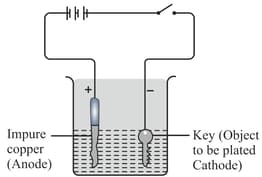NCERT Solutions for Chapter: Chemical Effects of Electric Current, Exercise 1: Exercise
NCERT Science Solutions for Exercise - NCERT Solutions for Chapter: Chemical Effects of Electric Current, Exercise 1: Exercise
Attempt the practice questions on Chapter 14: Chemical Effects of Electric Current, Exercise 1: Exercise with hints and solutions to strengthen your understanding. Science Textbook of Competency Based Questions for Class VIII solutions are prepared by Experienced Embibe Experts.
Questions from NCERT Solutions for Chapter: Chemical Effects of Electric Current, Exercise 1: Exercise with Hints & Solutions
Tia used four different objects to fill the gap in an electric circuit, separately.
The table shows what she found.

| Object in the gap | The bulb |
| Plastic | Does not glow |
| Copper wire | Glows brightly |
| Wooden block | Does not glow |
| Graphite stone | Glows dimly |
Which of these best conducts electricity?
Which of these is a chemical effect of electric current?
Which of these is a correct pair of an insulator and a conductor?
Will an electric device work if we place the positive terminal of a battery towards the negative point of the device? Explain your answer.
Electroplating is the process of adding a surface layer of metal on another metal.

Which of these is true about electroplating?
Which of these is an example of electroplating?
Sumit replaced all the bulbs in his home with LEDs. After a month, he noticed that the electricity bill had decreased. What was the most likely reason for the decrease in electricity bill?
Distilled water is a bad conductor of electricity. Why does rainwater conduct electricity?
